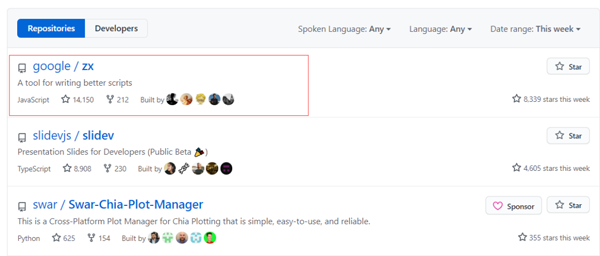大家都知道Bash很好用,但是在编写脚本时,人们通常会选择一种更方便的编程语言,比如JavaScript,但是Node.js库在使用之前还需要许多额外的操作,整体来说还是不够方便,最近谷歌开源了一个能够帮助开发者快速编写脚本的工具——ZX,短短几天就登上了Github热榜。
ZX的安装十分简单:
- npm i -g zx
接下来,你需要将你的脚本编写在带有.mjs扩展名的文件中,以便能够await在顶层使用。如果你喜欢.js扩展名,可以将脚本包装为void async function () {...}()。
将以下shebang添加到zx脚本的开头:
- #!/usr/bin/env zx
现在,你将能够像这样运行脚本:
- chmod +x ./script.mjs
- ./script.mjs
或通过zx可执行文件:
- zx ./script.mjs
常用命令举例
使用child_process包中提供的exec函数可以把字符串当做命令执行,并返回Promise<ProcessOutput>对象。
- let count = parseInt(await $`ls -1 | wc -l`)
- console.log(`Files count: ${count}`)
例如,要并行上传文件:
- let hosts = [...]
- await Promise.all(hosts.map(host =>
- $`rsync -azP ./src ${host}:/var/www`
- ))
如果执行的程序返回一个非零的退出代码, 将会抛出ProcessOutput对象:
- try {
- await $`exit 1`
- } catch (p) {
- console.log(`Exit code: ${p.exitCode}`)
- console.log(`Error: ${p.stderr}`)
- }
ProcessOutput
- class ProcessOutput {
- readonly exitCode: number
- readonly stdout: string
- readonly stderr: string
- toString(): string
- }
cd(),更改当前工作目录
- cd('/tmp')
- await $`pwd` // outputs /tmp
fetch(),对node-fetch包的包装:
- let resp = await fetch('http://wttr.in')
- if (resp.ok) {
- console.log(await resp.text())
- }
question(),对readline包的包装:
- type QuestionOptions = { choices: string[] }
- function question(query?: string, options?: QuestionOptions): Promise<string>
用法:
- let username = await question('What is your username? ')
- let token = await question('Choose env variable: ', {
- choices: Object.keys(process.env)
- })
sleep(),setTimeout函数的包装。
- function sleep(ms: number): Promise<void>
用法:
- await sleep(1000)
chalk包,该包直接可用无需导入内部脚本:
- console.log(chalk.blue('Hello world!'))
执行远程脚本,如果zx可执行文件的参数以开头https://,则将下载并执行该文件。
- console.log(chalk.blue('Hello world!'))
最后,附上ZX在Github上的项目地址:https://github.com/google/zx







































